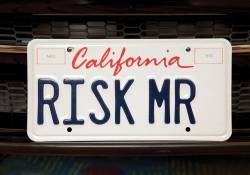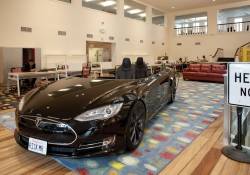The Riskmaster’s Adventure: Tim Draper

There is half of a black Model S Tesla SITTING in the reception area of the Silicon Valley’s Draper University of Heroes. Its owner, Tim Draper, isn’t even slightly concerned that someone might drive off in the groundbreaking electric car, a vehicle which won the 2013 World Green Car of the Year and Time Magazine’s Best 25 Inventions of the Year 2012, among other awards. This particular Model S isn’t drivable, you see: Draper has turned it into a desk. Indignant auto aficionados can breathe easy though: Draper had the blessing of Tesla CEO Elon Musk before turning the car into a piece of highly artistic furniture. Draper Fisher Jurvetson, the global venture capital firm that he co-founded with John H.N. Fisher and Steve Jurvetson, was one of the first companies to invest in Tesla, after all.
[highlight_text] We award points based on spectacular success or spectacular failure.” [/highlight_text]
“I talked to Elon,” the jovial, innovative 55-year-old recalls. It was given to me as a full chassis, and I got an artist to carve it into a desk. This was a great marketing opportunity [for Tesla], so we did it. It was great.” As part of the trifecta behind DFJ and its Global Network of Partner Funds, one of the world’s most active cleantech investors, Draper also practices what he preaches. He himself drives a Model S (one that hasn’t been gutted, of course), the eighth of its kind ever created, and he also purchased two additional Tesla Roadsters for his wife and sister. DFJ has also invested in more than 30 cleantech companies since 2001, including SolarCity, EnerNOC, Bright Source Energy, Edeniq and Intermatix.
“We [at DFJ] were pretty early investors before they even called it a green movement. We were early in our green investments, great, environmentally sound companies,” Draper says now, though admits that his greenest moment wasn’t an investment in one of the aforementioned companies, but in an entirely different venture which would save the environment as a result of its inception. “My greatest green movement was investing in Hotmail because of what it has saved and what it has created. We’re using the post office less, saving trees by cutting down on paper production, we’re not licking poisonous envelopes as much and we’re saving fuel as well by cutting down on the need to transport mail,” he says.
Draper, who has been awarded with the Commonwealth Club’s Distinguished Citizen Award for achievements in green and sustainable energy, is also attempting to go green in his latest, and, in his eyes, greatest, venture, his eponymous entrepreneurial university. “We’re trying [to make Draper University of Heroes into an eco-friendly environment,” he says. “It’s a very old building, but there are a few things we ultimately plan on doing there. We’re putting in solar panels, making improvements in the windows and we have some hydroponics there – the restaurant in our building has a living wall – which is kind of fun.”
“Fun” is definitely the word that comes to mind when describing not only Draper himself, but also his university. It is a school for entrepreneurs and innovators, a university that refuses to focus on the past and instead, is wholly devoted to the future. A central theme at the college is heroism and, more specifically, “super heroes.” To Draper, a hero is an innovator, one who is fearless and inspired. It is also a savior of comic book lore, a world in which he himself became immersed in after receiving a Spiderman comic for his 21st birthday. “I used to think I was Batman, but now I think I’m more Dr. X,” he laughs. It was his son who actually came up with the idea to turn Draper’s purchase of the former Benjamin Franklin Hotel into a university, and venture out, so to speak, on this new scholarly adventure.
[highlight_text] I used to think I was Batman, but now I think I’m more Dr. X. [/highlight_text]
“I have to give my son most of the credit,” he admits. “I bought the hotel because it was cheap, and I thought it was interesting. I asked my family, ‘What do you think I should do?’ Adam came up with this idea about turning it into a boarding school. Now, I know nothing about anything aside from entrepreneurship and heroism, but I put these things together and realized I could create a school unlike any other, where students could have a lot of the tools they’d need to go off and do really heroic and entrepreneurial things. We’re challenging the status quo.” So how does this school work? It isn’t for those who like to sit on their laurels, that’s for sure. Draper describes it as a place for people who have a “spark.”
“I don’t want to take four years of an entrepreneur’s life,” he says. “There are plenty of schools that give a great four-year education. My advice? Take a quarter off from Stanford or Berkeley and try it out. A lot of people learn from reading or listening, but I’m going after those people who do things to learn. We always have an activity here. Students have to make a presentation in front of the class almost every day.
“We’ve broken the curriculum down into five pieces,” he continues. “There’s future – predictive analytics and science fiction and cosmos—and survival training, urban and rural. In urban you’ve got four hours to get to San Francisco and get a job offer. It doesn’t matter what kind of job, you don’t have to take it, but the point is to get the offer. We also have a team of Special Forces trainers where we teach entrepreneurship, modern finance and advanced marketing. In finance we’ll teach things like Bitcoin and crowd funding, and we’ll teach viral marketing, crowd sourcing and social media. It all comes down to a two-minute presentation in front of a panel of venture capitalists.” His Silicon Valley-friendly institution isn’t for the masses, but then, that was never the intention. “It isn’t for everyone,” he admits. “It might be for students who are a little frustrated with the current education system, or those who have an idea that they’re just starting to obsess about. Those are the students we’re looking for at Draper University.”
In Draper’s world, there are no teachers, only speakers like Musk, Box founder Aaron Levie, STVP Executive Director Tina Seelig and Zappos founder and CEO Tony Hsieh. There is also an interesting grading system in place. “I’ve always thought that something was wrong with our grading system,” he explains. “If you get an ‘A’, it means you really didn’t make any mistakes, so we don’t operate that way. We award points based on spectacular success or spectacular failure.” This doesn’t just apply to his students, but to his own ventures, as well. Draper’s latest endeavor isn’t based on a point system, but he’s still hoping that it will skew towards the “spectacular success” end of the spectrum. With his “Six Californias” proposal, he is attempting to split California into six separate states, and has even begun collecting signatures through various grassroots organizations to get his initiative off the ground and running. “I’ve been working on [this proposal] for years, and realized that California was failing for years,” he says, explaining, “I grew up in a very different California. We had the best infrastructure and the best education system. We had quite an amazing state back then, but I’ve watched our education system go from first to 46th, and watched our infrastructure fall apart.”
This isn’t the first time he’s tried to implement change in California. He served on the California Board of Education in 1999 and ran a statewide school voucher initiative in 2000; he is also resonsible for creating BizWorld, a foundation that teaches children the basics of entrepreneurship, business and finance, in 1997. It’s understandable that he’s still trying to make positive changes in the Golden State, and, as usual, only natural that he has a plan. “We’ve drawn some lines based on demographics, political, economics, water and electricity; we’ve drawn the lines that we think are right,” he says. “Each of the regions of California have very different issues, different points of view. In Jefferson, they’re concerned about taxation without representation; they’re getting weird taxes that only affect them. Central California has issues with water rights and Silicon Valley is always concerned about the government staying in touch with technology. Down in Southern California, concerns are tied to the border and immigration. Western California has a lot of social issues like gun control and safety in schools. Each region has its own interest, and I think what’s happened is that these very good people who run California have done outstanding work but it’s ungovernable. The longer we wait, the worse it gets. It does take time for the consciousness of a state to come alive.”
Time is something Draper is finally allowing himself. Coming from a family of venture capitalists – his grandfather, William Henry Draper Jr., became the very first Silicon Valley venture capitalist in 1958; his father, William Henry Draper III, followed suit in 1962 – it was always clear he’d follow in his family’s footsteps. This is why he’s taken a three-year sabbatical from the company he co-founded to focus on other passions, like the school and his master plan to change his state. “I am still on the team at DFJ, and I’m continuing to take responsibility for all the funds we’ve invested in in the past. The funds go for about a three-year period. At the end of the three-year period, I’ll go back,” he explains, adding, “During this period, I can try new things. The venture business is changing. I can try new things where my hands aren’t tied. I do a lot of angel investing, and will continue to work still as a big investor and helper of new funds, so I’ll still be bringing new things to the table.”
He does not, however, plan on running for a political office during this three-year period if his Six Californias proposal does get approved. “I don’t want any political positions,” he says adamantly. “I want a better environment and a better place to live and work.” Thus, the man best known as “The Riskmaster” will continue to push the envelope, both personally and professionally. He will continue to take chances, because he knows that in the long run, you can’t succeed if you don’t try.
“Adventure means you take that first step,” he says. “What I do every day is take that first step. It could be adventures in the wild, or the adventure of creating Draper University of Heroes, or the adventure of creating Six Californias. Those are adventures where I’m taking the first step. I’ve jumped out of a helicopter into a lake and I’ve gone hang gliding. I’ve done plenty of death-defying things. Every single time I ask myself, ‘Where would I go, and how do I take the first step? There’s a new adventure around every corner; it’s been a great life so far.”



















